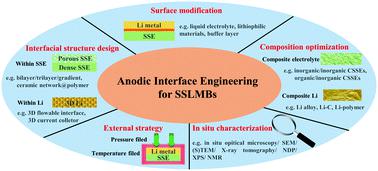当前位置:
X-MOL 学术
›
Mater. Horiz.
›
论文详情
Our official English website, www.x-mol.net, welcomes your
feedback! (Note: you will need to create a separate account there.)
Recent advances in anodic interface engineering for solid-state lithium-metal batteries
Materials Horizons ( IF 12.2 ) Pub Date : 2020-03-03 , DOI: 10.1039/d0mh00050g Changzhi Sun 1, 2, 3, 4, 5 , Yadong Ruan 1, 2, 3, 4, 5 , Wenping Zha 1, 2, 3, 4, 5 , Wenwen Li 1, 2, 3, 4, 5 , Mingli Cai 1, 2, 3, 4, 5 , Zhaoyin Wen 1, 2, 3, 4, 5
Materials Horizons ( IF 12.2 ) Pub Date : 2020-03-03 , DOI: 10.1039/d0mh00050g Changzhi Sun 1, 2, 3, 4, 5 , Yadong Ruan 1, 2, 3, 4, 5 , Wenping Zha 1, 2, 3, 4, 5 , Wenwen Li 1, 2, 3, 4, 5 , Mingli Cai 1, 2, 3, 4, 5 , Zhaoyin Wen 1, 2, 3, 4, 5
Affiliation

|
Lithium (Li) metal is recognized as the “Holy Grail” in the energy storage field because of its high specific capacity and ultralow anodic potential. To realize high-safety and high-energy-density rechargeable batteries, the marriage of Li metal and high-safety solid-state electrolytes (SSEs) may be a promising and irreplaceable choice. In this case, various advanced Li-containing and Li-free cathodes, such as LiNi0.8Co0.1Mn0.1O2 (NCM811), S and O2, can be adopted to further improve the energy density of solid-state Li-metal batteries (SSLMBs). However, regardless of the complex interface problems between different cathodes and SSEs, the poor anodic interface between the Li metal and SSEs has become the critical obstacle for the commercial application of SSLMBs, mainly including (i) poor interfacial contact and dendrite growth, (ii) chemical/electrochemical instability and (iii) chemo-mechanical expansion. In this review, we analyze the aforementioned anodic interface problems in SSLMBs. Based on these facts, advanced strategies to ameliorate the anodic interface by surface modification, interfacial structural design within SSEs and the Li metal, composition optimization of SSEs and the Li metal, and external methods such as pressure control and high temperature are systematically discussed. In situ characterization technologies are also introduced to understand the dynamic evolution of anodic interfaces. Moreover, we outline the future perspectives of anodic interface engineering for SSLMBs.
中文翻译:

固态锂金属电池阳极界面工程的最新进展
锂金属因其高比容量和超低阳极电势而被公认为是储能领域的“圣杯”。为了实现高安全性和高能量密度的可充电电池,金属锂与高安全性固态电解质(SSE)的结合可能是有前途且不可替代的选择。在这种情况下,可以使用各种先进的含Li和无Li正极,例如LiNi 0.8 Co 0.1 Mn 0.1 O 2(NCM811),S和O 2, can be adopted to further improve the energy density of solid-state Li-metal batteries (SSLMBs). However, regardless of the complex interface problems between different cathodes and SSEs, the poor anodic interface between the Li metal and SSEs has become the critical obstacle for the commercial application of SSLMBs, mainly including (i) poor interfacial contact and dendrite growth, (ii) chemical/electrochemical instability and (iii) chemo-mechanical expansion. In this review, we analyze the aforementioned anodic interface problems in SSLMBs. Based on these facts, advanced strategies to ameliorate the anodic interface by surface modification, interfacial structural design within SSEs and the Li metal, composition optimization of SSEs and the Li metal, and external methods such as pressure control and high temperature are systematically discussed. 还引入了原位表征技术来了解阳极界面的动态演变。此外,我们概述了SSLMB阳极接口工程的未来前景。
更新日期:2020-03-03
中文翻译:

固态锂金属电池阳极界面工程的最新进展
锂金属因其高比容量和超低阳极电势而被公认为是储能领域的“圣杯”。为了实现高安全性和高能量密度的可充电电池,金属锂与高安全性固态电解质(SSE)的结合可能是有前途且不可替代的选择。在这种情况下,可以使用各种先进的含Li和无Li正极,例如LiNi 0.8 Co 0.1 Mn 0.1 O 2(NCM811),S和O 2, can be adopted to further improve the energy density of solid-state Li-metal batteries (SSLMBs). However, regardless of the complex interface problems between different cathodes and SSEs, the poor anodic interface between the Li metal and SSEs has become the critical obstacle for the commercial application of SSLMBs, mainly including (i) poor interfacial contact and dendrite growth, (ii) chemical/electrochemical instability and (iii) chemo-mechanical expansion. In this review, we analyze the aforementioned anodic interface problems in SSLMBs. Based on these facts, advanced strategies to ameliorate the anodic interface by surface modification, interfacial structural design within SSEs and the Li metal, composition optimization of SSEs and the Li metal, and external methods such as pressure control and high temperature are systematically discussed. 还引入了原位表征技术来了解阳极界面的动态演变。此外,我们概述了SSLMB阳极接口工程的未来前景。











































 京公网安备 11010802027423号
京公网安备 11010802027423号